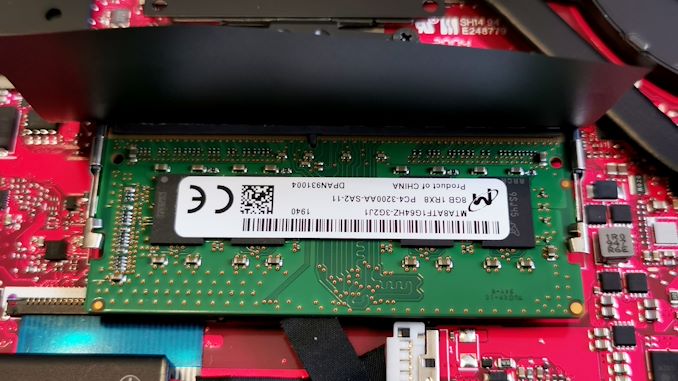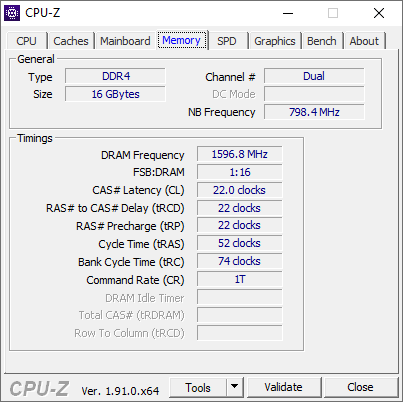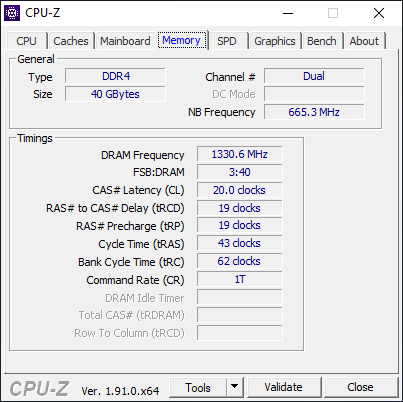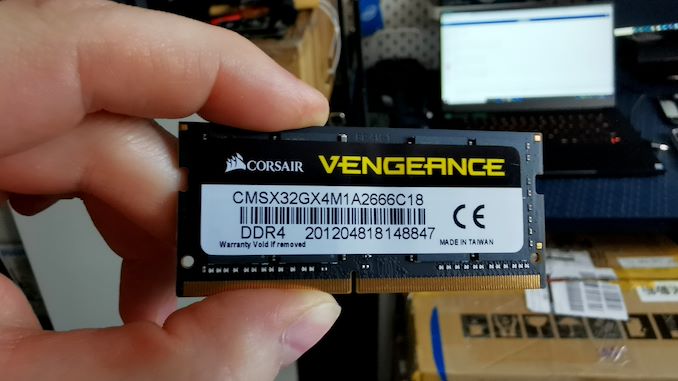AMD’s Mobile Revival: Redefining the Notebook Business with the Ryzen 9 4900HS (A Review)
by Dr. Ian Cutress on April 9, 2020 9:00 AM ESTRyzen 9 4900HS with DDR4-2666 and DDR4-3000
In our ASUS Zephyrus G14, we have a total of 16 GB of DDR4. This is split between a single SO-DIMM module of 8 GB, and a set of 8 GB memory soldered onto the board. AMD will offer a version with 16 / 16, however this might come at a later date.
This memory is running at the AMD recommended for these processors, DDR4-3200. Through our inspection tools, we can tell that this memory is running with subtimings of 22-22-22 with a command rate of 1T. The command rate is certainly good, however the 22-22-22 is a little slower than what we see on a desktop system running at this speed, because here we have a system that conforms to JEDEC’s subtiming requirements.
For our memory testing we wanted to see what speeds and capacities we could achieve. Corsair very kindly sent us some modules of 16 GB DDR4-3000 and a module of 32 GB DDR4-2666. This would give our system either 24 GB or 40 GB total respectively, which for a machine designed to do heavier duty workloads, having >16 GB is certainly welcome, as long as the performance hit isn’t too much.
I installed the 32 GB module, and the system booted first time with no fuss. A quick look to see if all the capacity was seen, and we had a total of 40 GB. The speed was also as expected, at DDR4-2666 but with subtimings of 20-19-19 1T.
However, when we put in the module of 16 GB DDR4-3000, to get a total of 24 GB, the detected speed inside the system was only DDR4-2666. Looking at the module settings, this was because the DDR4-3000 speed was actually an XMP profile, and ASUS has not enabled the ability to set XMP profiles here.
We were able to get DDR4-2666 on the 32 GB module because this is the base frequency and settings for the module. The same with the 8 GB module that came with the system – it was flashed so that the basic SPD setting was DDR4-3200. If users want to get high capacity modules with the faster DRAM speeds on this system, they will have to configure the primary SPD profile of their modules, which isn’t an easy thing to do.
As a result, our tests are going to come down to the 8 GB DDR4-3200 module that came with the system, and compare it to the 32 GB DDR4-2666 module. Note that the latter is an 8+32 configuration, which is expected to run in dual channel for the first 16 GB, and then single channel for the next 24 GB.



With our AI test, there’s a ~20% benefit from having the faster memory, which decreases slightly when moved to a limited power budget.

We didn’t see any difference in something like Cinebench.

There was more of a difference in PCMark 10, however PCM10 isn't that great in showing where the bottlenecks are.
Integrated Graphics Tests


For the Civ 6 graphics test, the difference in performance between the two memory settings is really significant. This sort of game cares less about FPS, however going down to 22 FPS for 1080p Max and No MSAA means that the user probably has to dial that back a bit to get something more reasonable.


Going from plugged in to not plugged in, we didn’t see much of a change with the slower memory, however the DDR4-3200 setting still gets a serious benefit over the DDR4-2666 arrangement.

For Final Fantasy, there a significant change - moving up from DDR4-2666 to DDR4-3200 affords a +30% improvement.
Discrete Graphics Tests




In each case, the faster DRAM actually improves discrete graphics performance.
Quick Thoughts
Overall, 16 GB of memory in a system like this isn't the best configuration - people who need the power are going to likely want 32 GB. However, users putting in their own fast module when buying the 16 GB version are going to have to be careful about the performance. Both the integrated graphics and the discrete graphics take a knock on performance going down from DDR4-3200 to DDR4-2666.















267 Comments
View All Comments
schujj07 - Thursday, April 9, 2020 - link
There are USB to Ethernet adapters that can be used.GreenReaper - Monday, April 20, 2020 - link
I imagine you won't get the fastest performance, but USB 3.x is a lot better than 2.0 (or wireless), and you can also get 2.5Gbps which you wouldn't get built-in.liquid_c - Thursday, April 9, 2020 - link
“IT pros” know that you can get just as stable of an internet connection via wireless. Something tells me you’re either a troll or just plain noob. I’d wager both.RSAUser - Thursday, April 9, 2020 - link
Not sure if you're trolling or not, assuming you believe it so, but no, Ethernet is always going to be more stable as less interference which means no chance of signal drops. My laptop is about 40cm from the router, I still use an Ethernet cable as it's more consistent in case my laptop decides the other access point is nicer.At work, no chance I'd consistently work on the WiFi, having over 120 machines connected to that would just destroy the bandwidth (remember, WiFi splits it according to how many devices are connected). Of those 120, around 80 are wired in, get around 15Mbps on WiFi.
Makaveli - Thursday, April 9, 2020 - link
lmao great troll post liquid_csonny73n - Saturday, April 11, 2020 - link
“ “IT pros” know that you can get just as stable of an internet connection via wireless. Something tells me you’re either a troll or just plain noob. I’d wager both.”You’re the troll and also a noob here. If you know anything about networking, you wouldn’t be spouting nonsense.
shady28 - Saturday, April 11, 2020 - link
I work in a multi-billion dollar company's IT department as a developer, 25 years now.It may not be strictly correct to say WiFi is equally as stable as wired, however I do not know a single developer that I work with (out of dozens) who uses their laptop wired for connection stability. 99.9% of the time it is not an issue at all - maybe once a year we see a wireless hiccup from a failing AP. This is in an office that houses thousands of people who almost universally use wireless.
schujj07 - Tuesday, April 14, 2020 - link
Whenever I get a ticket at work from someone complaining about their VPN connection not working, my first question is if they are using WiFi to connect to the internet. When they say yes, I ask them to try connecting over a wired connection. Not once have I had them say it didn't work after that. WiFi might work well for most connections, but it is more prone to signal loss and random latency spikes, and that affects VPNs for sure.hehatemeXX - Thursday, April 9, 2020 - link
Umm.. I doubt you two were going to, as you can easily just buy a usb to ethernet adaptor for a few $$Agent Smith - Friday, April 10, 2020 - link
Asus put a free LAN dongle in the box